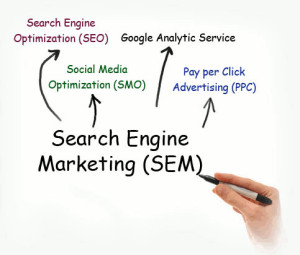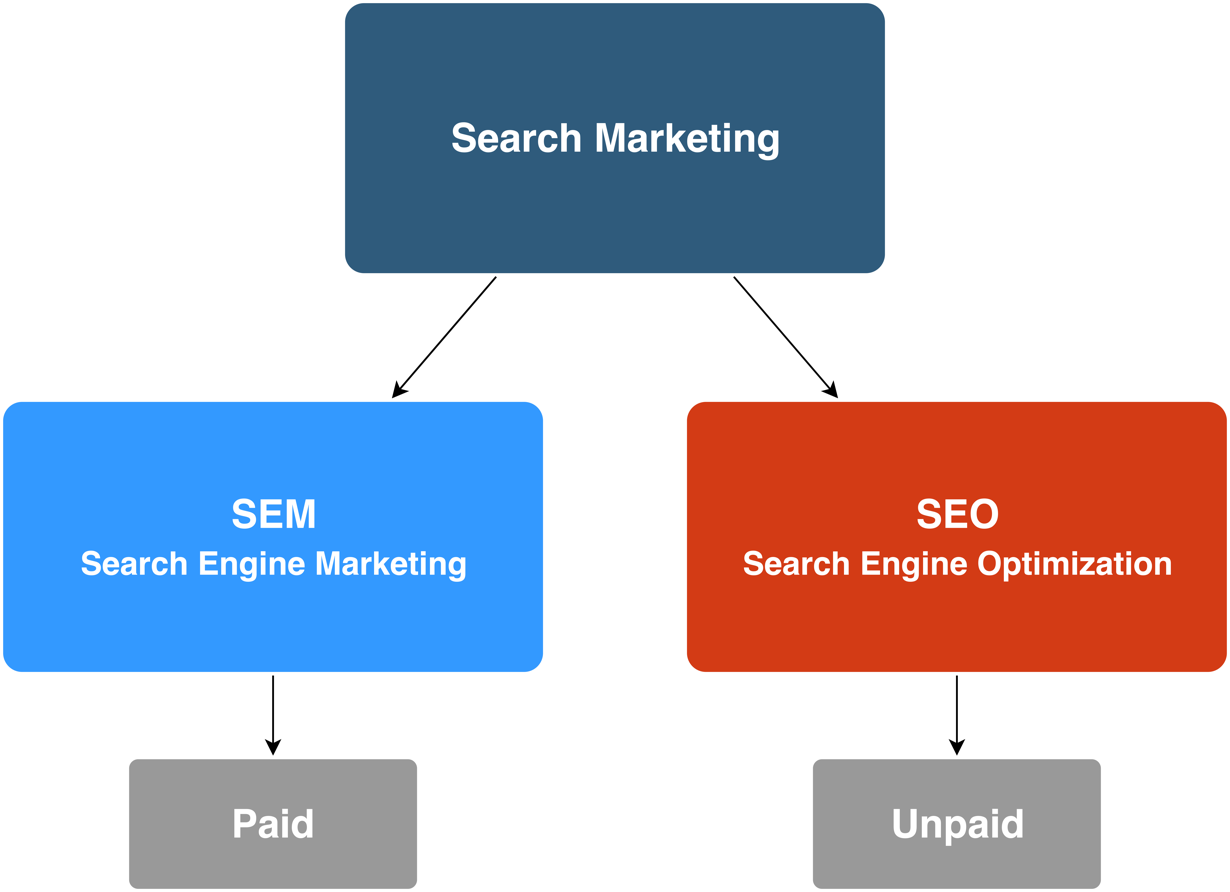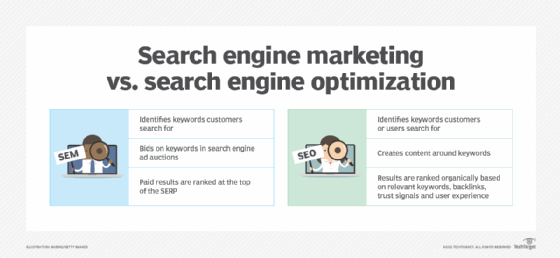What is the Difference between SEO and SEM: SEO focuses on improving organic search rankings, while SEM includes both organic and paid search strategies. SEM involves paying for ads to appear in search results.
Search Engine Optimization (SEO) and Search Engine Marketing (SEM) are vital digital marketing strategies. SEO aims to enhance a website’s visibility in organic search results through techniques like keyword optimization, content creation, and link building. SEM, on the other hand, encompasses SEO but also includes paid advertising methods like Pay-Per-Click (PPC) campaigns.
Businesses use SEM to quickly gain visibility by purchasing ads on search engines, which can drive immediate traffic. SEO requires time and ongoing effort but offers sustainable, long-term benefits without direct advertising costs. Both strategies are essential for a comprehensive online marketing plan, helping businesses attract and convert potential customers.

Credit: www.i7marketing.com
Introduction To Seo And Sem
Many confuse Search Engine Optimization (SEO) and Search Engine Marketing (SEM). Both help your website rank higher on search engines. SEO and SEM have different strategies and goals. Understanding these differences will help you choose the right approach for your needs.
Definition Of Seo
SEO stands for Search Engine Optimization. It involves optimizing your website to rank higher in organic search results. SEO focuses on improving your site’s visibility without paid ads.
SEO can be broken down into several components:
- On-page SEO: Optimizing content, HTML tags, and images.
- Off-page SEO: Building backlinks from other sites.
- Technical SEO: Improving site speed, mobile-friendliness, and security.
SEO is a long-term strategy. It requires patience and consistent effort.
Definition Of Sem
SEM stands for Search Engine Marketing. It is a broader term that includes both SEO and paid search advertising. SEM aims to increase visibility through paid ads on search engines.
Key components of SEM include:
- PPC (Pay-Per-Click): Paying for each click on your ad.
- Ad campaigns: Creating and managing ads on platforms like Google Ads.
- Keyword bidding: Bidding on keywords to display your ads.
SEM delivers faster results compared to SEO. It requires a budget for ad spending.
Comparison Table
| Aspect | SEO | SEM |
|---|---|---|
| Cost | Mostly free, but may involve some costs | Paid |
| Time to Results | Long-term | Short-term |
| Components | On-page, Off-page, Technical | PPC, Ad Campaigns, Keyword Bidding |

Credit: searchfacts.com
Core Components
The core components of Search Engine Optimization (SEO) and Search Engine Marketing (SEM) differ significantly. SEO focuses on organic search strategies, while SEM encompasses paid search tactics. Understanding the core components of each helps in crafting an effective digital marketing strategy.
On-page Seo
On-Page SEO involves optimizing individual web pages. The goal is to rank higher and earn more relevant traffic. Key elements include:
- Title Tags: Use targeted keywords.
- Meta Descriptions: Brief summaries of the page content.
- Header Tags (H1, H2, etc.): Structure your content.
- URL Structure: Use clean and keyword-rich URLs.
- Image Alt Text: Describe images with keywords.
- Content Quality: Provide valuable and engaging information.
Off-page Seo
Off-Page SEO focuses on activities outside your website. These activities aim to improve your site’s authority and reputation. Key strategies include:
- Backlink Building: Get links from reputable sites.
- Social Media Engagement: Share and promote content.
- Guest Blogging: Write posts on other blogs.
- Influencer Outreach: Collaborate with industry influencers.
- Forum Participation: Join discussions in relevant forums.
Paid Search Ads
Paid Search Ads are a core component of SEM. These ads appear at the top of search engine results. Key elements include:
- Keyword Research: Identify high-performing keywords.
- Ad Copy: Write compelling and relevant ads.
- Landing Pages: Optimize pages for conversions.
- Bid Management: Set and adjust bids for keywords.
- Performance Tracking: Monitor and optimize ad performance.
Key Differences
Understanding the differences between Search Engine Optimization (SEO) and Search Engine Marketing (SEM) is crucial for any digital marketing strategy. While both aim to increase visibility in search engines, they do so in distinct ways. This section will explore the key differences between SEO and SEM, focusing on cost implications and time to results.
Cost Implications
SEO typically involves organic methods to improve search engine rankings. This means you don’t pay for clicks. The costs are mainly in time and resources. You might spend on tools, content creation, and technical improvements.
SEM, on the other hand, involves paid strategies. You pay for each click on your ad. This can get expensive quickly, especially in competitive niches. You also need a budget for ad creation and management.
| Factor | SEO | SEM |
|---|---|---|
| Costs | Low to medium (tools, content) | High (ad spend, management) |
| Payment | None for clicks | Pay-per-click |
Time To Results
SEO is a long-term strategy. It can take months to see significant results. The focus is on building organic traffic over time. This involves optimizing your website, creating content, and earning backlinks.
SEM delivers immediate results. Once your ads are live, you can start getting clicks. This makes SEM ideal for short-term goals or seasonal promotions.
- SEO: Long-term strategy
- SEM: Short-term results

Credit: www.techtarget.com
Common Strategies
Both Search Engine Optimization (SEO) and Search Engine Marketing (SEM) share common strategies. These strategies help improve visibility and drive traffic. Let’s explore some of these common strategies.
Keyword Research
Keyword research is crucial for both SEO and SEM. It involves identifying words that potential customers use to search online. Use tools like Google Keyword Planner or SEMrush for this task.
Here is a simple table to understand keyword research tools:
| Tool | Best For |
|---|---|
| Google Keyword Planner | Basic keyword research |
| SEMrush | In-depth keyword analysis |
Content Optimization
Content optimization makes your content more visible to search engines. This involves using keywords naturally in your content. Optimize titles, meta descriptions, and header tags too.
- Use keywords in titles
- Include keywords in meta descriptions
- Optimize header tags (H1, H2, H3)
Ad Campaigns
Ad campaigns are a major part of SEM. Paid ads appear at the top of search results. Google Ads is a popular platform for this. Create targeted ads to reach your audience.
- Set a budget
- Define your target audience
- Create compelling ad copies
Tools And Platforms
Understanding the tools and platforms is essential for mastering Search Engine Optimization (SEO) and Search Engine Marketing (SEM). These tools help measure performance, analyze data, and optimize strategies. Below are some key tools and platforms used in both SEO and SEM.
Google Analytics
Google Analytics is a free tool that tracks website traffic. It provides insights into user behavior, traffic sources, and conversions. With Google Analytics, you can:
- Monitor website traffic
- Analyze user behavior
- Track conversions and goals
- Identify high-performing pages
These insights help optimize your SEO strategies for better performance.
Google Ads
Google Ads is a paid advertising platform. It allows businesses to create ads that appear on Google search results and partner websites. With Google Ads, you can:
- Create targeted ad campaigns
- Set budgets and bids
- Track ad performance
- Measure return on investment (ROI)
This platform is crucial for SEM as it helps businesses reach their target audience quickly.
Seo Software
SEO Software tools help optimize websites for search engines. These tools provide keyword research, backlink analysis, and site audits. Popular SEO software includes:
- Ahrefs
- SEMrush
- Moz
These tools offer features like:
- Keyword research
- Backlink analysis
- Site audits
- Competitor analysis
Such features are essential for improving search engine rankings and visibility.
Benefits And Drawbacks
Understanding the benefits and drawbacks of SEO and SEM helps make informed decisions. Both strategies enhance online visibility but have unique advantages and limitations. Let’s explore what sets them apart.
Advantages Of Seo
- Cost-effective: Organic traffic is free, requiring no ad spend.
- Long-term results: SEO builds sustainable online presence over time.
- Credibility: High-ranking organic results boost trust and authority.
- Better ROI: Higher return on investment due to lasting effects.
- Targeted traffic: SEO attracts users actively searching for information.
Advantages Of Sem
- Immediate results: SEM delivers quick visibility through paid ads.
- Controlled budget: Advertisers set and adjust their own spending limits.
- Precise targeting: Ads can target specific demographics and locations.
- Data insights: SEM provides detailed analytics for ad performance.
- Brand exposure: Paid ads increase brand awareness quickly.
Limitations Of Each
| SEO | SEM |
|---|---|
| Time-consuming: SEO takes months to show results. | Costly: SEM requires a consistent budget for ads. |
| Algorithm changes: Search engines update algorithms, affecting rankings. | Temporary: Ad results cease once the budget is exhausted. |
| Competitive: High competition for top organic spots. | Ad fatigue: Users may ignore repetitive ads over time. |
| Technical knowledge: SEO requires understanding of optimization techniques. | Click fraud: Competitors might click on your ads maliciously. |
Choosing The Right Approach
Selecting between Search Engine Optimization (SEO) and Search Engine Marketing (SEM) depends on several factors. Understanding your business goals, budget, and market competition can guide you. Each method has unique benefits and limitations. Below, we explore these factors to help you make an informed decision.
Business Goals
Your business objectives are crucial in deciding between SEO and SEM. If you aim for long-term growth and organic visibility, SEO is ideal. It builds your site’s credibility over time. Conversely, if you need immediate visibility and quick results, SEM is better. Paid ads can drive traffic quickly.
| SEO | SEM |
|---|---|
| Long-term growth | Immediate visibility |
| Organic traffic | Paid traffic |
| Builds credibility over time | Quick results |
Budget Considerations
Budget is another key factor. SEO requires less financial investment upfront. However, it demands time and effort. SEM needs a higher budget due to ad expenses. But it delivers faster results.
- SEO: Lower financial investment, higher time commitment
- SEM: Higher financial investment, faster results
Market Competition
The level of competition in your market affects your choice. In a highly competitive market, SEM can give you an edge. Paid ads can place you above competitors quickly. For less competitive markets, SEO can be more effective. It allows you to build organic traffic steadily.
- High competition: Consider SEM for quick visibility.
- Low competition: SEO can build sustainable growth.
Frequently Asked Questions
What Is The Difference Between Seo And Sem Search Engine Marketing?
SEO focuses on optimizing website content to rank higher in organic search results. SEM involves paid advertising to appear in search engine results pages.
What Are The Pros And Cons Of Seo Vs Sem?
SEO offers long-term results and organic traffic. SEM provides quick visibility and targeted ads. SEO is cost-effective but slower. SEM can be expensive but delivers immediate results. SEO builds authority, while SEM offers precise audience targeting.
What Are The Similarities Between Seo And Sem?
SEO and SEM both aim to increase website visibility. They use keywords and analytics to drive traffic. Both involve optimizing content and improving user experience.
How Do Seo And Sem Work Together?
SEO improves organic search visibility. SEM boosts visibility through paid ads. Together, they enhance overall search presence and traffic.
What Is Seo?
SEO stands for Search Engine Optimization. It involves optimizing websites to rank higher in search engine results.
Conclusion
Understanding the differences between SEO and SEM helps you create a balanced digital marketing strategy. SEO focuses on organic growth, while SEM includes paid advertising. Combining both can maximize your online visibility. Choose the right approach based on your goals and budget for optimal results.


